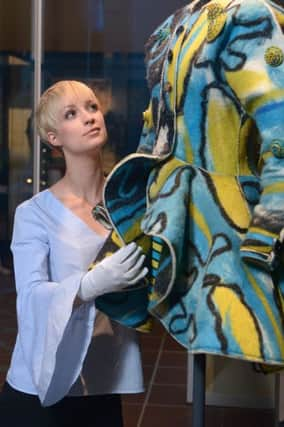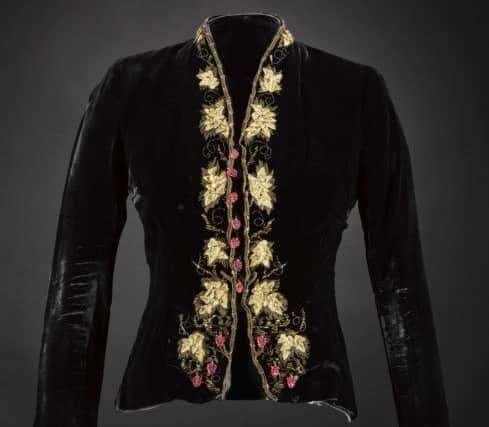How the National Museum of Scotland stays fashion-conscious


‘Historic silk just shatters,” says Georgina Ripley, 30, curator of modern and contemporary fashion and textiles at National Museums Scotland. “Even if it’s kept in a box, it still degrades over the years”
Clothes are rarely designed to last a lifetime, let alone centuries. Yet they are of major historical importance, in that every fold, stitch and embellishment tells us so much about their time and their owner.
Advertisement
Hide AdAdvertisement
Hide AdThis is something Ripley is well aware of. She’s spent the last three years, along with a team of designers and other experts, curating the National Museum of Scotland’s new Fashion and Style gallery. It showcases 88 dressed mannequins and over 400 individual objects, including sketches, patterns, textile samples, accessories, fashion illustrations, photographs and film.


Some of these were plucked from storage at the 50,000-strong fashion and textiles section of the National Museum Collections Centre in Edinburgh’s Granton.
“The museum was fortunate to acquire the Jean Muir archive, which is an estimated 18,000 items,” she explains. ”And we have the Bernat Klein archive, which consists of about 4,500 textiles, so those two things have vastly increased our holding”.
Ripley’s job has involved painstakingly editing this vast resource into a selection that will appeal to the National Museum of Scotland’s broad audience. There should be something to engage and intrigue everyone, from fashion students to historians, children to tourists.
“I think creating the gallery was about striking the right balance,” she explains. “There’s an academic side to fashion history, but that doesn’t always translate to a museum display. Everyone has clothing in their wardrobe, but it’s about presenting fashion in a way that everyone can relate to”.


Thus the pieces, which date from the 14th century onwards, aren’t arranged chronologically, but organised into themed sections, such as Body Image and Cutting Edge.
Designer names range from the familiar, such as Vivienne Westwood, Zandra Rhodes, Pucci and Jean Paul Gaultier, to newer stars, such as Craig Green and Mary Kantrantzou. Some items, like the Ossie Clark Ziggy Stardust dress, have been recently acquired, and others have been commissioned (like a hat by milliner Anya Caliendo). Then there’s the beaded frock, dated from 1927, that needed 150 hours of conservation work before they could consider it for display. All the exhibits have visual impact in common.
Advertisement
Hide AdAdvertisement
Hide AdRipley hopes visitors will be intrigued enough to read the accompanying label before exploring further using the museum’s new mobile experience, Mode. It offers additional material, such as the opportunity to see a piece in its historical context.
“There’s a 17th century embroidered linen doublet, which I hope people love as much as I do,” says Ripley. “It was created in a brief period when the doublet was worn short, with the shirt billowing out underneath and through the wide slashes in the sleeves. Through Mode we have the opportunity to contextualise this by showing portraits of how it would have been worn, and it’ll allow you to zoom in on the finer detail”.
Throughout the process, Ripley has got to know this, and some of the key pieces, intimately.
It’s generally only her, the assistant curators and the conservators who have physical contact with these items, which are usually kept safe from pests, dust and sunlight in their climate controlled repository.
So, which would she most like to own?
“That’d be the navy Jean Muir dress,” she says. “As I was moving it, I thought how amazing it was. It’s made from buttery soft nappa leather and is a classic style which never goes out of fashion.”
Another of Ripley’s favourites is the 17th century court mantua dress with hooped petticoat. It occupies a prime position, inside a specially made case as part of the Body Image section, which examines the silhouette from the 18th century to the 1950s. “It looks fantastic in the gallery, “ she says. “The gold thread that runs through it really sparkles in the light”.
According to Ripley, this piece, once believed to have belonged to the Countess of Haddington, managed to survive the centuries as it would have been worn very rarely, only at court. It is the historical equivalent of a red carpet frock (though with a skirt that makes the wearer almost three metres wide).
Advertisement
Hide AdAdvertisement
Hide Ad“It dates from the 1750s and, by that time, the skirts of your everyday dress wouldn’t have been as wide as this example, so it’s a court affectation,” she says. “We think the equivalent of just buying the material for that now would be about £5,000.”
In the gallery, it’s paired with a men’s suit from the same period.
“That has got these oversized, heavily embroidered cuffs,” says Ripley. “It’s very modest in comparison to the mantua but it reflects the shape of womenswear and offers an opportunity for people to see how extravagant menswear used to be. It was only from the 19th century onwards that this genre takes on a sombre palette and becomes what we’re more familiar with today”.
Sadly, there is no menswear equivalent to some of the pieces made during the golden age of couture, from 1947 to around 1960. The museum’s archive only holds one key piece of couture from that period – a pearlescent pink satin ball gown with matching cape. It dates from around 1948 and was designed by French couturier Jacques Fath – a peer of Christian Dior and Pierre Balmain.
“Fath is one of the designers credited with contributing to the rebirth of couture after the Second World War,” says Ripley.
Although many of the items on display are typical of the era they were created in, some have been chosen because they confound expectations. For example, the robe de style was a signature design of Jeanne Lanvin in the 1920s, when the straight-up-and-down flapper look was vogueish.
“We’ve got a beautiful example,” says Ripley, describing this lavender coloured dress. “It was an iconic piece for her, but it’s also interesting for our visitors, as the wider pannier hips are not what we typically associate with the decade.”
Advertisement
Hide AdAdvertisement
Hide AdOf course, French designers like Lanvin and Fath are well represented, but Scots also take a prime position in the gallery. They’re represented by, among other things, a hat donated by milliner William Chambers and a tartan outfit from the wardrobe of the iconic Frances Farquharson.
“She was reportedly a fashion editor for Vogue and Harper’s Bazaar in the 1920s and 30s, when she used to dress in couture and was specifically fond of Schiaparelli,” says Ripley. “She married a Highland laird later in life, moved to Scotland and started dressing head to toe in the Farquharson tartan, but still retained her sense of style and love of Eastern influenced clothing.”
One of the most exciting pieces in the Cutting Edge section was acquired from Edinburgh College of Art alumnus Holly Fulton, 38. It’s a Venetian wool and satinized organza dress from this designer’s Spring/Summer 2015 collection, which was inspired by folklore, sun worship and the Scottish dancer Margaret Morris. Ripley and Fulton chose this together, as it’s a piece that merges new materials with traditional techniques.
“It features die-cut sequins that have been folded into patterns of tessellating triangles – a time-consuming process,” explains Ripley.
Although the other sections of the gallery will remain the same, the Cutting Edge displays, which explore the use of new technologies, innovative materials and changing aesthetic conventions, will be rotated more frequently to reflect advances in the industry.
“That’s the fun part of my job – having those discussions with designers, thinking about what’s important and what we should know about,” says Ripley. “There’s so much more in the pipeline.”
ON TREND THROUGH THE AGES
The Fashion and Style gallery showcases the National Museum of Scotland’s internationally significant collection of textiles and fashion. It will explore how designers, producers and consumers have shaped fashion and is split into six sections: Designing and Making Fashion, Designing and Making Textiles, Fashionable Appearances, Dreams and Desire, Body Image and Cutting Edge. Some of the highlights are as follows:
Bump dress by Comme des Garçons, spring/summer 1997
Advertisement
Hide AdAdvertisement
Hide AdThis dress (right), conceived by Comme des Garçons designer and label founder Rei Kawakubo, was part of the Body Meets Dress, Dress Meets Body line (also dubbed “the lumps and bumps collection”). It included subversive pieces with padded shoulders, rumps and bellies, all of which played on beauty ideals. As Kawakubo put it, “The body becomes dress, dress becomes body”.
Chainmail tunic by Paco Rabanne, 1967
French designer Paco Rabanne trained as an architect, which may explain the structural form of his creations. This shimmery, light-reflecting dress, created using jewellery-making techniques, is an iconic example of Sixties style. At the time, Rabanne dressed stars including Twiggy and Jane Fonda, in her iconic role as space vixen Barbarella.
Black satin dress, owned by Joanna Lumley, Jane & Jane by Jean Muir, 1964
This is one of the pieces chosen by curator Georgina Ripley from the National Museum of Scotland’s huge archive of Jean Muir designs. It’s significant not only because of its beautiful cut and its signature simplicity, but because it was actor Joanna Lumley’s first Jean Muir purchase after she became a house model for Jane & Jane (Muir’s first design label).
Jacket by Schiaparelli, autumn/winter 1937/38
This rare black velvet jacket was chosen as it was a favourite design of Elsa Schiaparelli and was created during her peak, when she was collaborating with surrealist artists including Jean Cocteau and Salvador Dalí. It features the surface embellishment for which she is renowned and is a simplified version of the jacket worn by her in the famous portrait by Horst P Horst for Vogue.
Slap soled womens shoes, possibly Italian, 1660-1670
As the Fashion and Style gallery demonstrates, there have been some unusual trends over the centuries. These embroidered silk shoes feature a plinth-like second sole connecting the base, which makes a satisfying slapping sound as the wearer walks flat-footedly along.
Airmail dress by Hussein Chalayan, 2001
Chalayan designed this dress so that it could be written on (or not) folded up and popped in the post. Although it resembles paper, it’s actually Tyvek – a fabric that’s washable and unrippable. Thus, a few of the 200 or so that were produced have survived. Björk wore one of Chalayan’s similarly mail influenced pieces – a jacket – on the cover of her 1995 album, Post.